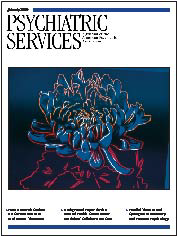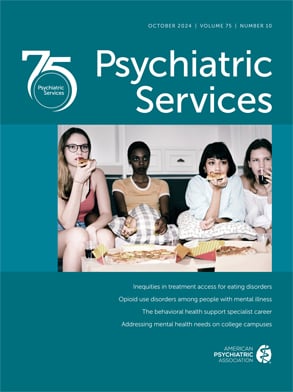To the Editor: We strongly support Ragins' call in the December issue for a transformation of mental health research to include the development of "practice-based evidence."
Our recent naturalistic statewide study of employment rates among clients of community mental health centers, which used administrative data, is an example of the search for practice-based evidence. Our study found a 69 percent discontinuation rate for second-generation antipsychotic medications. This rate is similar to the discontinuation rates found in the CATIE study. However, our naturalistic study also found that almost half of the individuals who discontinued treatment (46 percent) reinitiated second-generation medication within 18 months. Operating within the practice-based evidence paradigm broadened our perspective to include a fuller range of clinical practices in community settings.
Within the broader practice-based evidence paradigm, this study also provided information about the effectiveness of these medications. We found that 18 percent of individuals receiving second-generation medications were employed before discontinuing medication, but employment rates increased to 22 percent after the medication was discontinued (although this increase was not statistically significant.). A related study found that the initiation of second-generation antipsychotic medication was associated with a significant decrease in level of involvement with the criminal justice system (
1).
We have argued elsewhere for increased utilization of the administrative databases that are the hallmark of our information age (
2). Others have argued for balancing clinical trials with naturalistic community studies (
3). Although the strengths of clinical trials are well known, their weaknesses are frequently ignored. Primary among these weaknesses is the potential lack of representativeness of the samples. In the CATIE study, for instance, only 25 percent of participants were female (
4), which contrasts with the larger population of recipients of public mental health services. In our statewide study, 54 percent of adults who were receiving public mental health services for serious mental illness were female. Nationally, 52 percent of recipients of public mental health services who have a serious mental illness are female (
5). The underrepresentation of women, as well as other potential selection biases, can seriously diminish the ability of such studies to reflect and inform clinical practice.
We believe that the important public policy questions raised by Ragins' critique of the CATIE study will be best addressed by a systematic program of research that incorporates both clinical trials and observational studies by using administrative databases. This combination of approaches to community-based research will provide a better understanding of the efficacy and effectiveness of antipsychotic medications and the broader range of clinical practices than is provided by either research paradigm alone.

